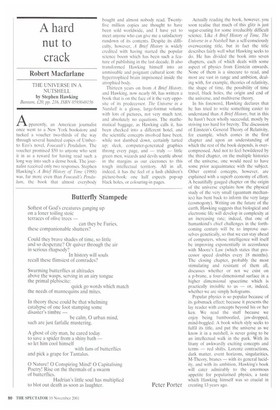A hard nut to crack
Robert Macfarlane
THE UNIVERSE IN A NUTSHELL by Stephen Hawking Bantam, £20, pp. 216, ISBN 0593048156 Apparently, an American journalist once went to a New York bookstore and tucked a voucher two-thirds of the way through several hundred copies of Umberto Eco's novel, Foucault's Pendulum. The voucher promised $50 to anyone who sent it in as a reward for having read such a long way into such a dense book. The journalist received only two responses. Stephen Hawking's A Brief History of Time (1988) was, far more even than Foticauit's Pendulum, the hook that almost everybody bought and almost nobody read. Twentyfive million copies are thought to have been sold worldwide, and I have yet to meet anyone who can give me a satisfactory rundown of its contents. Despite its difficulty, however, A Brief History is widely credited with having started the popular science boom which has been such a feature of publishing in the last decade. It also transformed Hawking himself into an uninissable and poignant cultural icon: the hypertrophied brain imprisoned inside the atrophied body.
Thirteen years on from A Brief History, and Hawking, now nearly 60, has written a book that is on the face of it the very opposite of its predecessor. The Universe in a Nutshell is a glossy, large-format volume with lots of pictures, not very much text, and absolutely no equations. The mathematical baggage, as Hawking calls it, has been checked into a different hotel, and the scientific concepts involved have been, while not dumbed down, certainly tarted up: sleek, computer-generated graphics throng every page, and — truly — little green men, wizards and devils scuttle about in the margins as our cicerones to this tough intellectual territory. All in all, indeed, it has the feel of a lush children's picture-book: one half expects pop-up black holes, or colouring-in pages.
Actually reading the book, however, you soon realise that much of this glitz is just sugar-coating for some irreducibly difficult science. Like A Brief History of Time, The Universe in a Nutshell has a self-consciously overweening title, but in fact the title describes fairly well what Hawking seeks to do. He has divided the book into seven chapters, each of which deals with some aspect of physics from Einstein onwards. None of them is a sinecure to read, and most are vast in range and ambition, dealing with, for example, theories of relativity, the shape of time, the possibility of time travel, black holes, the origin and end of the universe, and multiverse theory.
In his foreword, Hawking declares that he has tried to write something easier to understand than A Brief History, but in this he hasn't been wholly successful, mostly by striving too hard for brevity. The discussion of Einstein's General Theory of Relativity, for example, which comes in the first chapter and upon an understanding of which the rest of the book depends, is overcompressed. And not to feel bewildered by the third chapter, on the multiple histories of the universe, one would need to have some prior acquaintance with the subject. Other central concepts, however, are explained with a superb economy of effort. A beautifully gauged chapter on the origin of the universe explains how the physical study of the very small (quantum mechanics) has bent back to inform the very large (cosmogony). Writing on the future of the earth, Hawking suggests that biological and electronic life will develop in complexity at an increasing rate; indeed, that one of humankind's chief challenges in the forthcoming century will be to improve ourselves genetically, so that we can stay ahead of computers, whose intelligence will itself be improving exponentially in accordance with Moore's Law (which states that processor speed doubles every 18 months). The closing chapter, probably the most stimulating and resistant of them all, discusses whether or not we exist on a p-brane, a four-dimensional surface in a higher dimensional spacetime which is practically invisible to us — or, indeed, whether we are simply holograms.
Popular physics is so popular because of its gobsmack effect; because it presents the lay reader with concepts beyond his or her ken. We read the stuff because we enjoy being bamboozled, jaw-dropped, mind-boggled. A book which slyly seeks to fulfil its title, and put the universe as we know it in a nutshell, is never going to be an intellectual walk in the park. With its litany of awkwardly exciting concepts and terms — red shifts, Lorentz contractions, dark matter, event horizons, singularities, M-Theory, branes — with its general lucidity, and with its ambition, Hawking's hook will cater admirably to the enormous appetite for popularised physics, a taste which Hawking himself was so crucial in creating 13 years ago.














































































































 Previous page
Previous page